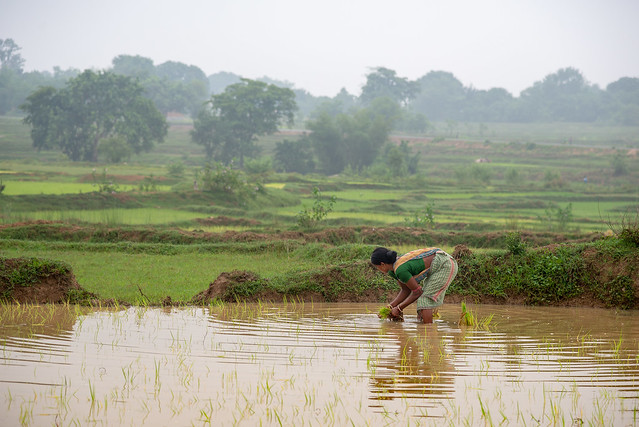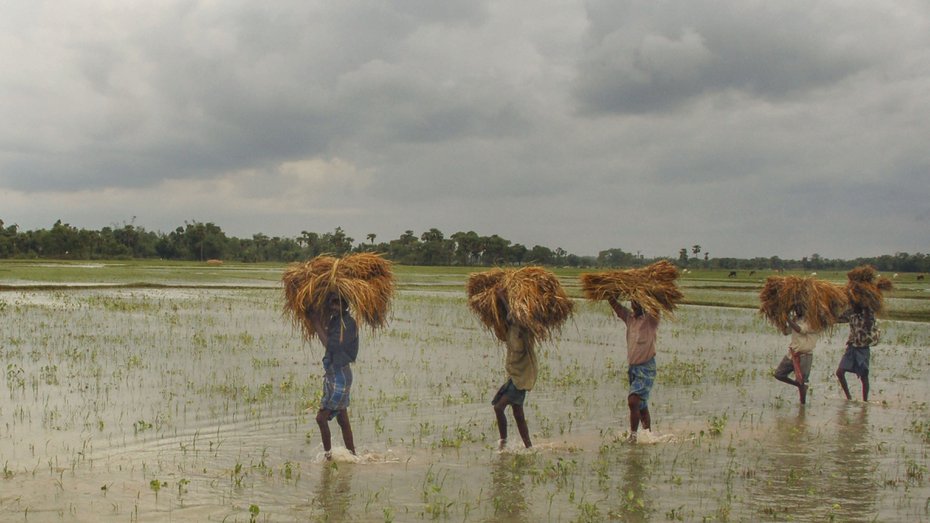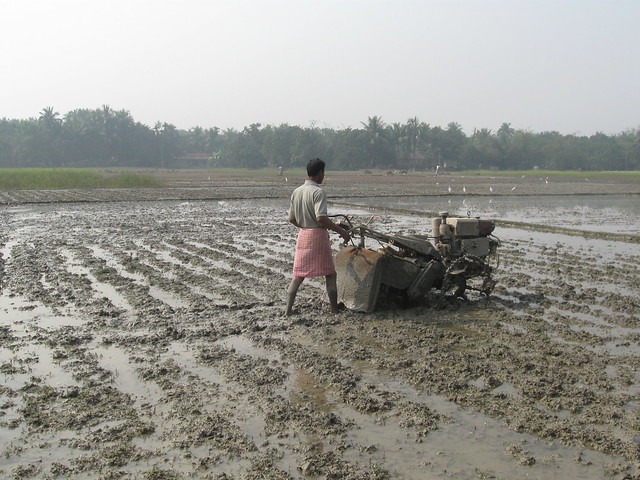After suffering lockdown losses in the boro paddy season, farmers in the rice bowl of Bengal face delay in sowing aman paddy
Farmers in large parts of West Bengal grow three paddy crops a year — boro (summer), aus (autumn) and aman (winter). Due to the lockdown, they suffered losses in the boro paddy season. Now marginal farmers and sharecroppers have no money to undertaken aman paddy this year


Photo: flickr
Although it is the start of the aman (winter paddy) season in Purba Bardhaman, the rice bowl of West Bengal, sharecropper Mustafa Mallick is a worried man. “Forget having money to buy paddy seeds and create seed beds, I’m struggling to recover from the massive loss I incurred last season of boro (summer) paddy,” the resident of Shikarpur village in Kalna-I block told Gaon Connection.
Like other farmers in the region, because of the nationwide lockdown, Mallick had to delay the harvest of boro paddy on the farm plot he had taken on lease from a landlord – he had agreed to pay 5 bags of paddy per bigha for the 7 bigha unirrigated plot. Most rice farmers in Bengal take three paddy crops a year. Aman is sown in July-August and harvested in winter; aus sown in summer along with the pre-monsoon showers and harvested in autumn; and boro sown in winter and harvested in summer.
“When I couldn’t wait any longer, I harvested the boro paddy even though the state was under a lockdown. But, I could bring home only a small part of boro produce, about 22 bags, as labour and transportation charges were very high, and few phore (rice traders) were trading,” he said. “Traders offered to buy paddy at half the normal rate. I sold one bag for Rs 500-600 instead of the normal price of Rs 1,000-1,200,” he added.
The agony of Mallick doesn’t end here. He had kept about 53 bags of paddy in his leased field, which were completely destroyed by the recent Cyclone Amphan and thunderstorms. “I have lost at least Rs 26,000-27,000 on boro paddy… I don’t think I will be able to take a plot on lease and farm this season,” he lamented.
The only survival option for him is to work as a daily wager.

Extensive damage to summer crops
Three years back, in 2017, Purba Bardhaman district was carved out of the erstwhile Bardhman district, the largest producer of paddy in the country. In many parts of Purba Bardhaman, where water is available in abundance throughout the year, farmers harvest aman in winter, aus in autumn and boro in summer.
When the first phase of lockdown was enforced on March 25, most farmlands in the district were lush with boro paddy, vegetables and other crops. Gaon Connection spoke with several farmers in Kalna-I and Memari-II blocks of the district who informed they managed to work in their fields under the lockdown as agriculture was exempt from restrictions, but had to delay harvest owing to severe shortage of the labour.
“We normally harvest boro paddy between mid-April and the first week of May. But this year, due to the lockdown, all the migrant workers had already left. Transportation was also difficult and expensive, and few phore (rice traders) were around to buy our paddy,” Montu Das, a sharecropper in Memari-II block told Gaon Connection.
Das and several other farmers said Cyclone Amphan dashed whatever hopes they had of limiting losses sustained through the lockdown.
A preliminary crop damage assessment report prepared by the Purba Bardhaman district agriculture department on May 22 has pegged the value of damaged crops at Rs 299 crore. Cyclone Amphan destroyed 42,000 hectares (ha) of paddy, 18,800 ha of sesame and 5,000 ha of vegetables, and several other crops, noted the report.

Worst hit – sharecroppers, landless labourers
“By this time of the year, most farmers begin preparing seed beds for aman and raising paddy saplings. But things are different this year due to the combined effects of the lockdown, Amphan and kalbaisakhi (nor-wester) storms, all of which have together hit the farmers,” said Probhat Das, secretary of the All India Cultivators Association – Krishak and Krishi Sahayak (farmers and farm-related) based in Kalna-I block. “The worst hit are the sharecroppers and landless agricultural labourers, who have no money to undertake sowing-related activities and there is no farm work available,” he added.
According to him, seeding activities were delayed by a fortnight in several parts of the state as small and marginal farmers, and sharecroppers found it difficult to access credit at the start of the season.

“Compensation for damaged crops could have provided some money to the farmers to undertake sowing activities. But all we are getting from the administration and the insurance companies are promises of compensation,” complained Probhat Das. He alleged since 2017 most farmers in Purba Bardhaman had not received any compensation against crop damages. Also, whatever compensation comes goes to the landowners and not the sharecroppers. For unirrigated plots, sharecroppers pay landowners 5 bags of paddy per bigha; for irrigated plots, they share 50 percent of the produce with the owner.
“We do farming on land owned by others to be able to eke out a living. We put in all the labour, and yet, when there is a calamity, we receive no compensation. Whatever produce we manage to save, like we did before Amphan, the owner takes his share away,” lamented Mallick.

Whereas farmers are a worried lot, the administration claims there is no cause for concern even if there has been a delay in the seed bed preparation. “The window for transplanting saplings from seed beds to the field is between July 15 and August 15. The monsoon has started off well, too, so we are not worried,” Jagannath Chatterjee, deputy director of agriculture, Purba Bardhaman told Gaon Connection.
On making credit available to marginal farmers and sharecroppers, he said, “We are holding camps in distant blocks and villages to provide all farmers, including sharecroppers, with Kisan Credit Cards, through which they can access interest-free loans from banks.” The enrolments target of his department in the district for this season alone is 171,000 cards. “This is over and above the 432,000 plus farmers in the district who already have Kisan Credit Cards,” he added.
A number of farmers and sharecroppers are coming forward to enrol for the Kisan Credit Cards, especially after the losses suffered during the Cyclone Amphan, acknowledged Probhat Das.
However, how useful these cards actually will be to help farmers access interest free loan only the time will tell. For now, the immediate concern of farmers in the rice bowl of Bengal, such as Mustafa Mallick and Montu Das, is the lack of finance to undertake aman paddy this season.

